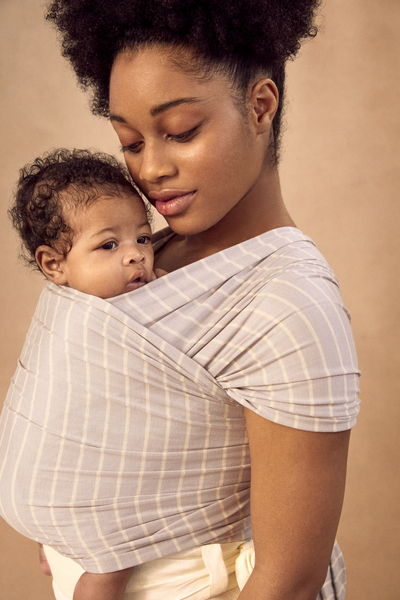
Babywearing is a cherished practice that offers numerous benefits for both parents and their little ones. From promoting bonding and closeness to allowing parents to keep their hands free, babywearing can be a game-changer. However, it’s not uncommon for babies to resist being in a wrap, creating moments of frustration for parents. In this guide, we’ll explore strategies to help make babywearing more enjoyable for both you and your baby, ensuring that it remains a cherished part of your parenting journey.
Understanding Your Baby’s Resistance
Understanding why babies may resist being in a wrap is essential for addressing their needs and ensuring a positive babywearing experience. Here are common reasons why babies may resist being in a wrap and their explanations:
- Discomfort or Improper Positioning: Babies are sensitive to discomfort, and improper positioning in the wrap can make them fussy. It’s crucial to ensure that your baby is placed correctly in the wrap, with their legs in an ergonomic “M” shape (froggy position) to prevent discomfort or strain on their hips. Tight or twisted fabric can also lead to discomfort, so make sure the wrap is adjusted properly.
- Overstimulation or Tiredness: Babies, especially newborns, can become overstimulated easily. If they have been exposed to too much sensory input, they may become overwhelmed and resist being in the wrap. On the other hand, if your baby is tired, they might be too sleepy to enjoy being in the wrap. It’s important to recognize your baby’s cues for overstimulation or tiredness and provide a calm environment to help them settle.
- Need for More Physical Contact: Babies have an innate need for physical contact with their caregivers. Sometimes, when they resist the wrap, it may be because they crave more closeness and skin-to-skin contact. This need for physical connection is natural and should be acknowledged and respected. Consider practicing skin-to-skin contact outside of the wrap, especially during moments when your baby desires more intimate bonding time.
The Importance of Listening to Your Baby’s Cues: Paying close attention to your baby’s cues and signals is fundamental in understanding their resistance. Babies communicate through their body language, facial expressions, and cries. By tuning in to their cues, you can better understand their needs and respond accordingly. If your baby is showing signs of discomfort or restlessness while in the wrap, take a moment to assess their positioning and comfort. If they appear overstimulated or tired, create a quiet, soothing environment. And if they crave more physical contact, spend some quality time holding them skin-to-skin, even without the wrap.
Choosing the Right Baby Carrier or Wrap

Selecting the right baby carrier or wrap is crucial to ensure your baby’s comfort and your ease of use. There are various options available, including wraps, slings, and soft-structured carriers, each suited for different needs and preferences. Consider your baby’s age and your own comfort when choosing a carrier. Proper sizing and fit are essential, so take the time to find the right one for both you and your baby.
The Aura Wrap is newborn friendly through about one year of age. It’s soft, cozy, and easy to pack in your diaper bag to take with you on any adventures big or small. But it’s also the perfect companion for those slow, fourth-trimester days at home where bonding is the most important thing on your to-do list.
The Ultimate Guide to Skin-to-Skin Bonding with Baby
Preparing Your Baby for the Wrap
Creating the right environment for babywearing is key to a successful experience. Ensure that the surroundings are calm and peaceful. Timing matters; choose a moment when your baby is neither too hungry nor too tired. Dress your baby appropriately for babywearing, considering the weather and ensuring they are comfortable.
Adjusting the Wrap Properly
Properly adjusting the wrap is crucial for your baby’s safety and comfort. Follow a step-by-step guide to wrapping your baby, making sure they are securely and comfortably positioned. Avoid common mistakes in wrapping, and don’t hesitate to seek help or watch tutorials if you’re unsure about the technique.
Engaging Your Baby While in the Wrap
Once your baby is in the wrap, engage them in interactive activities to keep them content. Talk, sing, and incorporate gentle movements. Skin-to-skin contact is a beautiful way to promote bonding and ensure your baby feels secure and loved.
Troubleshooting Challenges
When your baby seems uncomfortable while babywearing in a wrap, addressing their discomfort is essential for a positive experience. Here are strategies for addressing baby discomfort issues:
- Adjusting the Wrap:
– Check the Positioning: First, ensure that your baby is positioned correctly in the wrap. Their legs should be in an ergonomic “M” shape, and their back should be well-supported. Make any necessary adjustments to align your baby’s body properly.
– Smooth Out Wrinkles: Check for any wrinkles or folds in the fabric of the wrap. Smooth them out gently to eliminate pressure points that might be causing discomfort.
– Reposition Your Baby: If your baby’s head or neck seems strained, gently reposition them so that their head is well-supported and not leaning forward or to the side. Make sure their face is visible and not covered by fabric.
– Check for Overheating: Ensure that your baby is not too warm. Overheating can lead to discomfort. Dress them appropriately for the weather and consider using a lightweight wrap if it’s hot.
- Dealing with a Fussy or Crying Baby:

– Assess Basic Needs: First, check if your baby’s basic needs are met. Ensure they are well-fed, have a clean diaper, and are not too hot or cold. Addressing these needs can often calm a fussy baby.
– Comfort and Soothe: Sometimes, a gentle pat or soothing touch can help calm a fussy baby while in the wrap. Softly talk to your baby or sing a lullaby to provide comfort.
– Movement: Babies often find comfort in gentle movement. Rocking or swaying while babywearing can help soothe a fussy baby. A slow walk or a gentle bounce can work wonders.
– Take Breaks: If your baby is persistently fussy and you’ve addressed all their needs, it’s okay to take short breaks from babywearing. Comfort them outside of the wrap for a while and try again later.
- Seeking Support from a Babywearing Group or Consultant:
– If you find that your baby continues to be uncomfortable in the wrap despite your best efforts, consider reaching out to a local babywearing group or a babywearing consultant. They can provide hands-on guidance and support to ensure you’re using the wrap correctly and address any specific concerns related to your baby’s comfort.
Schedule a Free Fit Check with a Babywearing Consultant
Gradual Introduction to Babywearing
If your baby is resistant to the wrap, consider starting with short sessions and gradually increasing the duration. Build a positive association with the wrap by incorporating enjoyable activities while babywearing. Be patient and flexible, as your baby’s preferences may change over time. Typically, once you’ve gotten the hang of the wrap and mastered the right fit, your baby should enjoy their time against their favorite human!
Babywearing is a beautiful practice that offers numerous benefits for both parents and babies. By understanding your baby’s needs, choosing the right carrier, and following these strategies, you can create a positive and enjoyable babywearing experience. Remember that every baby is unique, so finding what works best for you and your little one is key. Embrace the benefits of babywearing for bonding and convenience, and cherish the special moments of closeness it brings to your parenting journey.



